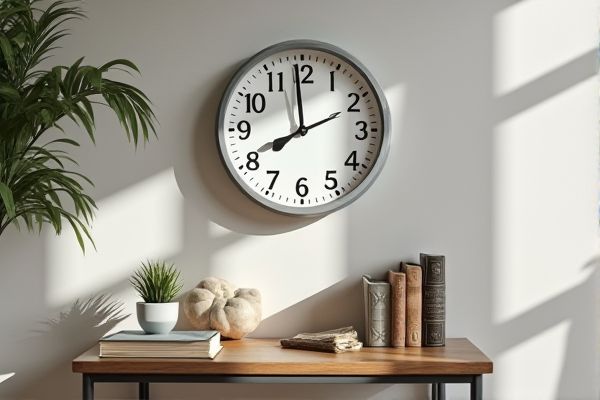
Analog clocks display time through rotating hands on a numbered dial, offering a classic and visually intuitive way to read hours, minutes, and seconds. Understanding the differences between analog and digital clocks can help You choose the best option for Your needs; continue reading to explore their features, advantages, and ideal uses.
Table of Comparison
| Feature | Analog Clock | Digital Clock |
|---|---|---|
| Display Type | Hands on dial with numbers or markers | Numeric digital display (LED/LCD) |
| Time Reading | Requires reading positions of hour, minute, second hands | Direct numerical time display (hours:minutes:seconds) |
| Accuracy | Depends on mechanical or quartz movement | Highly accurate; often synced with atomic standards |
| Power Source | Mechanical winding or batteries | Batteries, electricity, or solar power |
| Design & Aesthetics | Classic, traditional look with varied styles | Modern, minimalistic or multifunctional designs |
| Additional Features | Limited; sometimes includes chimes or date | Alarms, timers, backlight, date, stopwatches |
| Readability | Can be challenging in low light or for quick reading | Easy to read in all lighting; clear digits |
| Price Range | Varies from affordable to luxury mechanical models | Generally affordable; advanced features may raise cost |
Introduction to Analog and Digital Clocks
Analog clocks display time using rotating hour, minute, and sometimes second hands on a numbered dial, providing a visual representation of the passage of time. Digital clocks present time through numerical digits on electronic screens, offering precise and easily readable time information. Both types serve essential roles in daily timekeeping, with analog clocks emphasizing traditional design and digital clocks prioritizing clarity and functionality.
History and Evolution of Timekeeping
Analog clocks, first developed in the 14th century, showcase the evolution of mechanical engineering with their rotating hands and numbered dials, becoming the dominant form of timekeeping for centuries. The 20th century introduced digital clocks, revolutionizing time display through electronic circuits and LED or LCD screens, enhancing accuracy and readability. Advances in quartz oscillators and microprocessors further propelled the transition from traditional analog mechanisms to precise digital wristwatches and clocks.
Design and Visual Differences
Analog clocks feature a circular face with rotating hands that point to numbers or markers, offering a classic and elegant design ideal for traditional or decorative spaces. Digital clocks display time numerically on an LED or LCD screen, providing a modern, straightforward reading that enhances visibility and precision. Your choice between these designs can influence the aesthetic and functionality of your space, balancing timeless charm against contemporary clarity.
Accuracy and Precision Comparison
Analog clocks rely on mechanical movements that may experience slight inaccuracies due to wear and calibration, whereas digital clocks use quartz oscillators that provide superior precision with minimal deviation. You can expect digital clocks to maintain time within a few seconds per month, making them ideal for applications requiring exact timekeeping. Analog clocks, while aesthetically pleasing and functional, generally cannot match the consistent accuracy provided by digital technology.
User Experience and Readability
Analog clocks offer a more intuitive grasp of time passage through the visual representation of clock hands moving around the dial, aiding in quick estimation of elapsed or remaining time. Digital clocks provide precise numerical time display that enhances readability, especially in low-light conditions or for individuals with difficulty interpreting analog formats. User experience varies with context: analog clocks support spatial understanding, while digital clocks excel in clarity and instant time recognition.
Power Source and Durability
Analog clocks typically use a simple mechanical movement powered by batteries or winding mechanisms, contributing to their long-lasting durability and low energy consumption. Digital clocks rely on electronic components and usually require batteries or direct electrical power, making them more vulnerable to power interruptions but often featuring advanced functionality. The durability of analog clocks generally surpasses digital ones due to fewer electronic parts susceptible to damage or failure over time.
Maintenance and Longevity
Analog clocks generally require less frequent maintenance, relying on mechanical parts that, when well-oiled, can last for decades without needing replacement. Digital clocks, while often more accurate and easier to read, depend on electronic components and batteries that typically need regular replacement or repairs to maintain functionality. Your choice between the two should consider whether you prefer a low-maintenance, long-lasting timepiece or one that demands periodic upkeep but offers modern features.
Cost and Accessibility
Analog clocks generally cost less to produce and purchase, making them more accessible for budget-conscious buyers or educational environments. Digital clocks often come with advanced features like alarms, backlighting, and additional functions, which can increase their price but enhance usability. Your choice depends on whether you prioritize affordability and simplicity or multifunctionality and ease of reading.
Applications in Everyday Life
Analog clocks are commonly used in traditional wall clocks, wristwatches, and educational tools for teaching time concepts to children, offering a visual representation of time passage. Digital clocks dominate in devices requiring precise time reading, such as smartphones, microwaves, and alarm clocks, providing exact numerical displays. Both types serve essential roles in homes, offices, and public spaces, balancing aesthetic preferences with functional clarity.
Choosing the Right Clock for Your Needs
Selecting the right clock depends on your preferences for readability and style; analog clocks offer a classic look and help improve time-telling skills, while digital clocks provide precise, easy-to-read time at a glance. Consider the clock's placement and purpose--analog clocks enhance decor in living spaces, whereas digital clocks excel in environments requiring quick and accurate time checks. Your choice should align with your lifestyle and the specific functionality you need from a timekeeping device.
 homyna.com
homyna.com